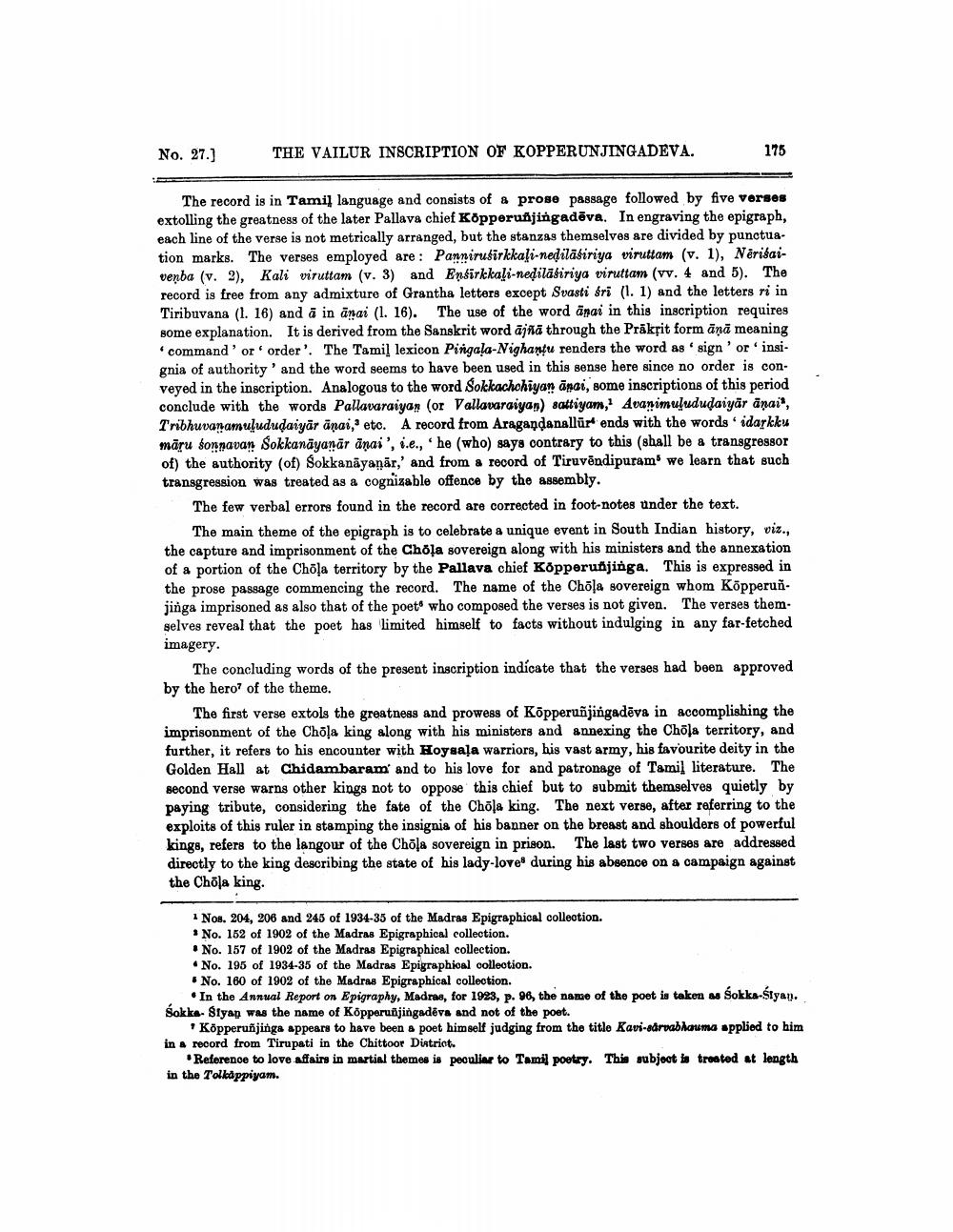________________
No. 27.)
THE VAILUR INSCRIPTION OF KOPPERUNJINGADEVA.
175
The record is in Tamil language and consists of a proge passage followed by five vorses extolling the greatness of the later Pallava chief Kopperuñjingadēva. In engraving the epigraph, each line of the verse is not metrically arranged, but the stanzas themselves are divided by punctuation marks. The verses employed are: Pannirusirkkați-nedilāśiriya viruttam (v. 1), Neribaiveņba (v. 3), Kali viruttam (v. 3) and Ensirkkaļi-nedilāsiriya viruttam (vv. 4 and 5). The record is free from any admixture of Grantha letters except Svasti sri (1.1) and the letters ri in Tiribuvana (1. 16) and ä in āņai (1. 16). The use of the word ārai in this inscription requires some explanation. It is derived from the Sanskrit word ajñā through the Prākpit form änā meaning
command' or order'. The Tamil lexicon Pingala-Nighantu renders the word assign' or 'insignia of authority and the word seems to have been used in this sense here since no order is conveyed in the inscription. Analogous to the word Sokkachohiyan anai, some inscriptions of this period conclude with the words Pallavaraiyan (or Vallavaraiyan) sattiyan, Avarimulududaiyār anai", Tribhuvanamusududaiyar anai, etc. A record from Aragandanallürt ends with the words idarkku māru sonnavan Sokkanāyanär änai', 6.e., he (who) says contrary to this (shall be a transgressor of) the authority (of) Sokkanayanår,' and from a record of Tiruvēndipuram we learn that such transgression was treated as a cognizable offence by the assembly.
The few verbal errors found in the record are corrected in foot-notes under the text.
The main theme of the epigraph is to celebrate a unique event in South Indian history, viz., the capture and imprisonment of the Chola sovereign along with his ministers and the annexation of a portion of the Chola territory by the Pallava chief Kopperutjinga. This is expressed in the prose passage commencing the record. The name of the Chõļa sovereign whom Köpperuñ. jinga imprisoned as also that of the poet who composed the verses is not given. The verses them. selves reveal that the poet has limited himself to facts without indulging in any far-fetched imagery.
The concluding words of the present inscription indícate that the verses had been approved by the hero of the theme.
The first verse extols the greatness and prowess of KÕpperuñjingadēva in accomplishing the imprisonment of the Chola king along with his ministers and annexing the Chola territory, and further, it refers to his encounter with Hoysaļa warriors, his vast army, his favourite deity in the Golden Hall at Chidambaram' and to his love for and patronage of Tamil literature. The second verse warns other kings not to oppose this chief but to submit themselves quietly by paying tribute, considering the fate of the Chola king. The next verse, after referring to the exploits of this ruler in stamping the insignis of his banner on the breast and shoulders of powerful kings, refers to the langour of the Chola sovereign in prison. The last two verses are addressed directly to the king describing the state of his lady-loved during his absence on a campaign against the Chola king.
Nos. 204, 206 and 248 of 1934-35 of the Madras Epigraphical collection. No. 162 of 1902 of the Madras Epigraphical collection. .No. 157 of 1902 of the Madras Epigraphical collection. • No. 195 of 1934-35 of the Madras Epigraphical collection. • No. 160 of 1902 of the Madras Epigraphical collection.
• In the Annual Report on Epigraphy, Madras, for 1923, p. 96, the name of the poet is taken m Sokka-Stya). śokke Slyan was the name of Köpperuñjingadēva and not of the poet.
Köpperunjinga appears to have been a poet himself judging from the title Kavi-edruablauma applied to him in a record from Tirupati in the Chittoor District.
Reference to love affairs in martial themes is peculiar to Tamil poetry. This subject to treated at length in the Tolkappiyam.




